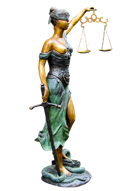A way of thinking about inclusive courthouse design
Parts I & II
Judge Celeste F. Bremer, US Magistrate Judge
Emily Gloe Donovan, RA
Susan Oldroyd, FAIA, LEED
Kristina Kobulsky, RA, LEED AP
Beyond the Blindfold: New Ways of Seeing Justice
At a recent AIA AAJ Conference, we were invited to challenge the participants by asking them to re-think their approaches to traditional courthouse design: columns, volume, circulation, and expressions of strength, power and formality through site, material and icons. Through a lively discussion, we shared our premise: Courts are Gendered, and that Gender is Male. One of the ways that the justice system expresses its maleness is through design choices. Gender is a cultural construct. Symbols can only communicate if there is context, and you understand the message sent. For example, we stop at red lights and go on green, regardless of what any text written on them actually says. Red/green in traffic has its own meaning; blue/pink in childrens' clothing has its own meaning—whether or not that message is intended, it is received.
We invite you to consider some of the meanings that are incorporated in courthouse design, and hope that this discussion will help you have a more robust conversation with your client, the public, or judges about why traditional court design sends message that might not fit modern evidence-based, trauma-informed, practices, or even Thomas Jefferson's design, for a democratic courthouse.
Part I
Courts and Courthouses are Gendered, and that Gender is Male
This premise seems to put people on edge. If you aren't familiar with some of the anthropological and sociological literature on this topic, the concept of gendered institutions strikes you as odd. Using the term "gendered" is meant to make you think, and to become more mindful about how we use architecture to express cultural values. A gendered organization is one that is predominated by one sex (we know this is not strictly binary, and that sex is not gender; these are discussions for another day). When you think of nurses and teachers, your mind calls up images of women. When you think of firefighters, coaches, or judges your mind calls up images of men. Gendered institutions adopt the lens of the majority, and that becomes the morn for size, space, and semiotics. It allows references that express the values of the group, and communicate what is normal or acceptable behaviors.
Historically, male judges and architects have been responsible for court and other civic building design; they have defined and shaped the law and how it is applied. Government buildings, particularly courts, express stability, security, and power. They are buildings where the public has limited access to certain areas, often with extra security inside and outside. Through choices of materials, design, access, and symbols, courthouses read male.
We are not judging whether these traits are 'good or bad', we challenge you only to recognize this reality, and ask whether, in a mindful way, we should bring a balance represented by feminine values to these worlds. We posit that inclusion of more feminine representations in design and material would result in a greater perception of fairness in process and result. We ask: who are the representations of women in courthouses, namely Justicia, blindfolded"? Does she need to be blindfolded to ensure fairness, or is she better represented with her eyes wide open to both justice and injustice? Once you begin to ask why we've traditionally made some design choices, you can decide whether more expanded options might be appropriate.
Let's take a look at some terms below, and how they might influence this thought process, and the conversation we hope you have within AIA AAJ, with clients, and the public.
|

|
Cultural Construct: Characteristics people attribute to social categories, such as gender, are defined by culture. Because our brain requires a quick reference we sometimes need to speak in simplified terms (stereotypes): pink versus blue, red/green; uniform or robe versus suits or orange jumpsuits, among others. We associate male traits with strength, power, and authority. We associate female traits with support, communication, and reconciliation.
|
|

|
Implicit Bias: Unconscious understanding or values that affect our actions. We can't be neutral, because we've all been raised within a certain culture, with a particular background, and a specific point of view, in a point in time. The key is to be mindful of our biases, and keep them in check. If you'd like to learn more about the science of 'Implicit Bias and Mindfulness', take the Implicit Association Test (IAT).
|
|

|
General Mainstreaming: In designing and reviewing organizational and institutional development, gender mainstreaming is a globally accepted strategy for promoting gender equality. If you have power, you think it drops out of the equation. If you do not have power, it is always a factor in your action and reaction. Gender mainstreaming posits that it is appropriate to consider a gender's role in a society when assessing how systems operate, and that barriers to full participation in society should be assessed; maybe the barriers cannot or do not the ability to be mindful is required. Learn more about gender mainstreaming >
|
|

|
Equality vs. Justice: Just because everyone is given something identical, doesn't mean it is fair. Being neutral is not the same as being fair; this is where mindfulness applies. Fairness and justice are cultural constructs, also. They require comparison of circumstances and assessment of values. While it may seem that using a "one size fits all" approach results in fairness, we know that it does not. Buildings and systems should be adaptive to the needs of the variety of people and situations that occur within them. For more on this, read One student’s thoughts on the illusion of equality… and the need for justice >
|
Working from the premise that law is a gendered institution, and that gender is male, let's look at some courthouse traits that "read" male. If you do not see them the same way, then ask yourself why, and have a conversation with others to check their read. Becoming aware of how these buildings speak to you, and others, is important in developing mindfulness about how to improve design for inclusion, democracy and fairness—in addition to justice.
Part II
Justicia: Symbols and Symbolism
In looking abstractly at a symbol such as Justicia, can this help us define male and female attributes?
|

|
Why is Justicia female?
The female Egyptian Goddess Maat used a feather to weigh against the heart. This seems like a feminine attribute of using the heart as a measure, rather than only viewing evidence. We see that ascribing a gender to justice begins to influence our assumptions and implicit bias. What would happen if we portrayed justice as genderless?
|
|

|
Why does Justicia hold a sword and scales?
The symbolism indicates that she carries strength and power by wielding the sword, and shows balance and fairness by holding the scales. The sword is a more masculine symbol, representing physical strength, authority and vengeance. If her sword was sheathed in a scabbard, does that make her neutral? Neutered? Does she still carry strength and power? Does the scale still balance and show fairness?
|
|

|
What materials are typically used in creating Justicia?
The use of stone and bronze are used to represent strength and permanence. What if softer more ephemeral materials are used? Would wood, tapestry or vegetation be considered more feminine? Are they not as valued, because they have a shorter life expectancy? Do lighter weight materials convey less power?
|
|

|
Why is Justicia veiled in a diaphanous gown?
The "classical" representation is modeled after ancient Roman or Egyptian influences. Look at other depictions of the Virtues. Most people do not have an education or understanding of the classic virtues. To rely on this cultural context to represent Justicia today with exposed breasts and distorted proportions, it reads as sexualizing her.
One of the supposed basis for judicial robes is that they hide the person, making judges generic, and thus neutral, (or they are just a variation of scholars gowns, and no one gave any thought to fairness, just conveniences). But if you believe neutral connotes fairness, then Justicia should be wearing an oversized, opaque cloak, which does not distinguish gender, economic status, or other classification. What if she was entirely transparent, with the exposed honesty and beauty of a confident well-proportioned female figure? Does she need a cover at all, using the human heart, mind and body literally as the scale?
|
|

|
Why is Justicia often blindfolded?
Most of us believe that she wears a blindfold, so she is not influenced by who or what is appearing before her, allowing objective impartiality. Actually, it was added to represent Justicia's willful blindness to unfairness and injustice that was occurring before her, that she was incapable of stopping.
There are additional connotations of female blindfolds in modern society: sexual overtones, a sign of weakness, or that she cannot bear to witness the truth. She is often shown in cartoons as peeking from beneath the blindfold with one eye, as a commentary that she actually knows what is going on, which leads to bias. What if we always chose Justicia with her eyes wide open? Acknowledging that strength and wisdom are found in knowledge, not willful ignorance of reality—and that emotions play a role in decision-making.
|
We need to further this conversation with AIA, our clients and the community to be more mindful of the choices we make about how courts are run, and how courthouses are designed.
*Part III of this article is scheduled to be published in the next issue of the AAJ Journal 2018.
(Return to the cover of this 2018 AAJ Journal issue)